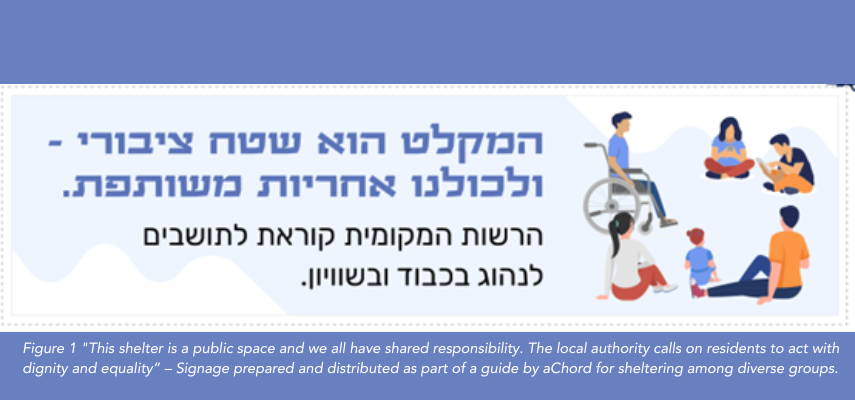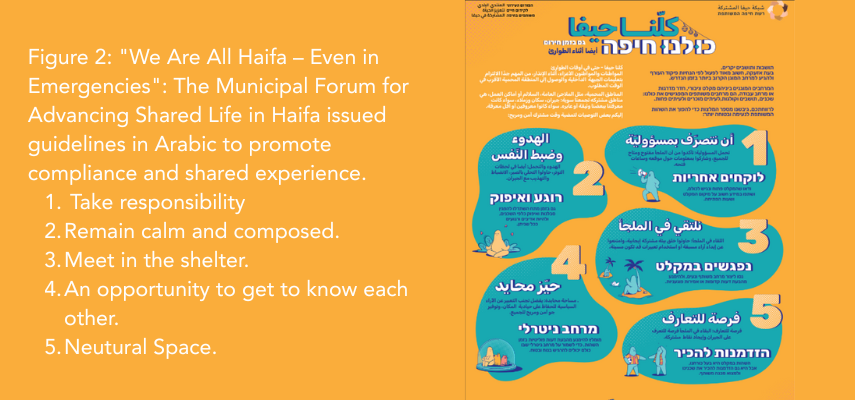Emergency Response Needs of Arab Communities in the War with Iran
Since October 7th, Israeli society has been entrenched in a near-constant state of emergency. Beyond the ongoing conflict and hostage crisis in Gaza, the rapidly escalating war with Iran is now exacting a heavy toll, claiming lives, causing unprecedented property damage, and thrusting all Israeli citizens into a precarious reality fraught with danger, destruction, and a pervasive sense of fear and uncertainty.
Both Jewish and Arab communities continue to endure significant losses. As of June 20, 24 Israeli citizens have been killed, hundreds injured, and over 5,110 rendered homeless in the war with Iran. Iranian missiles do not discriminate between populations, placing all Israeli citizens under constant threat. Yet, like other marginalized groups, Arab citizens face infrastructure gaps and unique challenges in preparing for and responding to emergency.
Emergency Preparedness and Coordination in Arab Society
Emergency coordination for Arab society has been ongoing in some capacity since October 7, building on experiences from both the current war and the COVID-19 crisis. As a result, many of the major areas of need are already known – in particular, lack of access to adequate shelter. However, the urgency and scale of Iranian missile and drone attacks underscore certain priorities. Emergency response coordinators are working on raising awareness and improving communications to ensure public compliance with safety guidelines and shelter use. In parallel, they are working with local authorities to train municipal workers and volunteers, supply essential equipment for emergency preparedness, and effective search and rescue efforts in the event of a direct hit. In addition, increased tensions and low levels of trust between Jews and Arabs remain a concern with respect to incitement, access to shelters in mixed cities and shared spaces, and an overall heightened level of fear and insecurity.
Access to Shelter
The gap in access to adequate shelter in Arab communities is substantial and has drawn significant attention since October 7th. According to joint research by Sikkuy-Aufoq and Injaz (April 2025), 46% of Arab citizens still lack access to shelters, compared to 26% of the general population. 60 out of 71 Arab municipalities surveyed had no public shelters whatsoever. For example, in Tamra, an Arab city of 37,000 residents, “there is not a single public shelter.” Meanwhile in a nearby Jewish town, Mitzpe Aviv, with a population of only 1,100, “there are 13 public shelters.”
The most critical disparities in protection are found in the Negev Bedouin community, particularly in unrecognized villages. According to the Negev Situation Room established in June by AJEEC-NISPED and the Regional Council of Unrecognized Villages, the shelters still functioning among “approximately 450 mobile shelters deployed since October 7th” serve only “about 15% of the nearly 100,000 residents of the unrecognized villages.” These areas also often lack missile alert systems, leaving residents exceptionally vulnerable during emergencies.
In mixed cities and public spaces where Jews and Arabs may need to find shelter together, there are additional challenges. There have been several incidents in which Arab citizens have been barred from entering public shelters. Beyond reflecting tensions between Jewish and Arab citizens, stories like these travel quickly in the Arab community and may become a deterrent to seeking shelter in mixed public places. Several organizations are issuing guidelines and resources, like the prepared signs in Figure 1 created by aChord, to promote and generate readiness for inclusivity.

Emergency Communication Infrastructure
Along with shelter, access to and compliance with official guidelines also saves lives during emergencies. Unfortunately, crucial information from trusted resources in Arabic often fails to reach Arab communities promptly, resulting in delays in compliance and coordination. A report on recent injuries finds that “some of the injured were hurt because they went out to film interceptions and did not follow the Home Front Command’s instructions.”
In many cases, Arab citizens may not be aware of existing public shelters in their localities. Public protected spaces, such as mosques, schools, and community centers in Arab towns, are being added to Waze application, making it easier for people to locate shelter. This effort is being managed and coordinated by local authorities in partnership with Injaz, an NGO specializing in local governance. Still, variability in the app’s accuracy, the lack of formal street names and addresses in many Arab communities, and inconsistent Wi-Fi and cell reception mean implementation gaps remain.
On the national level, the government’s Authority for Economic Development of the Minorities Sector at the Ministry of Social Equality allocated NIS 1 M this week for targeted broadcasts and digital campaigns within the Arab community. They are focusing on podcasts and radio stations like Nas Radio and Makan Radio, alongside other digital campaigns. Other local initiatives (Figure 2) are also issuing resources and guidelines in Arabic. Emergency response coordination teams underscore that additional coordination with local authorities and volunteers is necessary to ensure these messages reach all communities.

Local Authorities’ Emergency Preparedness
Local authorities are generally the front-line bodies for emergency preparedness and response in Israel. However, Arab local authorities are generally less equipped to manage emergencies effectively. The wide reach of Iranian strikes has also raised additional concerns, especially in central and southern communities, where lower historical exposure has led to less emphasis on preparedness compared to the north.
Preparedness at the level of local authority includes public communication and guidance for residents, staff and volunteers training, equipment and planning for different scenarios and the unique challenges in Arab towns. In the current crisis, trained and well-equipped search and rescue (SAR) teams are essential for carrying out life-saving operations after missile strikes. As such, volunteer training and equipment provision for SAR teams have become urgent priorities.
A Home Front Command report on the recent direct strike on a home in Tamra, which resulted in the deaths of four Arab women, highlights how gaps affect immediate response capacities. According to the report:
- “Firefighting, security, and rescue equipment exists only at a basic level and is not suited for large-scale destruction.
- The city has no organized system of generators or wireless communication devices that can be used in total blackouts.
- Traffic control and evacuation equipment exists only in partial form and without neighborhood-level deployment.
- No neighborhood emergency supply depots are available, hindering immediate response at moments of crisis.
- During the recent critical incident, it took over 25 minutes for firefighting forces to arrive. Civilian vehicles could not access the area. Entrances were blocked. The area had no lighting, no rescue markers, no evacuation equipment, and no mobile reception – no way to communicate.”
According to a mapping of needs underway by the volunteer emergency coordinator for the National Council of Heads of Arab Local Authorities (NCHALA), local authorities are reporting on several top priority needs to strengthen their emergency preparedness and response capabilities:
- Advanced search and rescue (SAR) training and the provision of rescue and relief equipment stand out as the most critical, with over 70 authorities citing the need.
- Basic SAR training and the distribution of personal protective equipment and rescue kits was named by 58 authorities.
- There is a growing awareness of the importance of psychological first-aid training, highlighted by 61 authorities, reflecting the need to address mental health alongside physical safety during emergencies.
- Specialized first aid training for mass casualty events is also an immediate priority.
To meet these needs, localities face a significant challenge in expanding their volunteer base. According to the mapping, an estimated 7,000 additional volunteers must be trained, highlighting the need for accessible training programs and adequate resources to equip them.
In parallel, equipment shortages are most acute in Arab communities in the Negev and central regions, where there is a significant lack of personal protection kits or rescue bags for volunteers, as well as essential heavy equipment for search and rescue such as trucks, lighting systems, and generators.
Ongoing Mapping
The summary of needs aggregated above reflect life-saving interventions that can be implemented under urgent conditions. As the situation progresses, the mapping will be updated across additional areas of need, such as mental health, health care, prevention of incitement and de-escalation of Jewish-Arab tensions, and other areas of community resilience. To learn more about specific needs and opportunities to support Arab communities in these or other areas, reach out to the Task Force.
How Can We Help?
Do you need support integrating these resources and issues into your philanthropic, communal, or Israel education work? Reach out for consultations, connections to experts, program support, training, or to plan your next event or mission. If you’ve used our resources, tell us about your experience!


